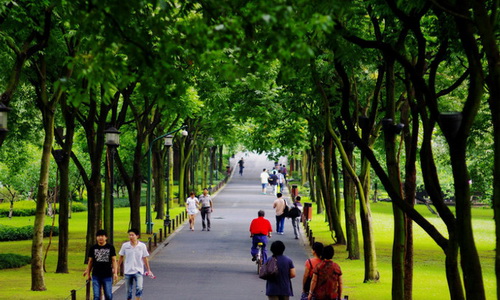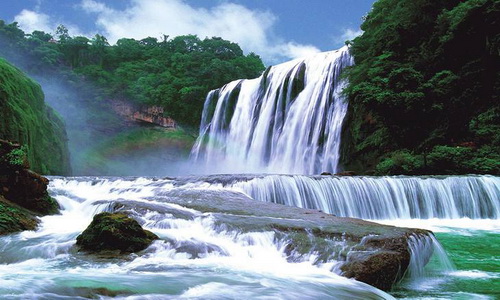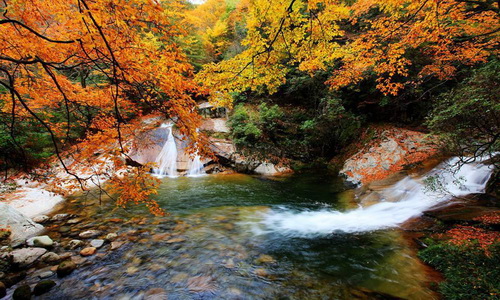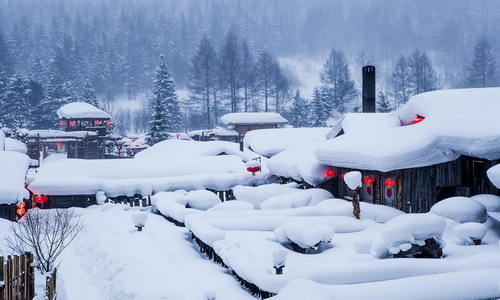Best Time to Visit China
Generally speaking, the best time to travel in China are the spring (March-May) and the autumn (September to early November). During these two seasons, there is less rain and clearer skies in most regions of the country, and travelers could achieve an enjoyable trip to China with pleasant weather and comfortable temperature.
However, as a huge country of diverse landscapes and climates, China has something spectacular to offer in each season. Truly, winter could be chilling and cold especially in northern China, but one could seize the yearly chance to indulge in the ice and snow world. Moreover, there are wonderful escapes where a comfortable winter could be enjoyed, such as the all-year-round spring city like Kunming and Dali, as well as warm places with plenty of sunshine and beaches.
Sightseeing in some historical and cultural destinations is little influenced by the climates and weather of different seasons. Therefore, the best time to visit will depend on the destination you want to go and your travel preferences.
The majority part of China gets distinctive four seasons: warm spring from March to May, vibrant summer from June to August, cool autumn from September to November and cold winter from December to next February. Here below display the weather in different seasons and suggest the places to go and experiences to enjoy.
- Spring: March - May
- Summer: June - August
- Autumn: September - November
- Winter: December - February
Warm and comfortable, spring is one of the most ideal time to visit China, as it sees a lot of dry days and pleasant temperatures of 10 - 23°C. Spring winds may bring some drizzles, but also create more refreshing air. In mid-spring, everything warms up and plants on the land would come to life, too. It is a season of colors and vitality, which is perfect for outing in the mountains and countryside.

During this season, the pleasant climate is ideal for trips to nearly every part of China. It could be dry in places like Beijing, Xian and Shanghai, so you shall seize the time to make a trip before it turns hot and humid. Furthermore, Hangzhou, Suzhou, Chengdu and Guilin are popular destinations to go on a spring outing. Li River in wet season is suitable for a cruise to soak up the breathtaking hills by the waterfront. The water towns near Suzhou and Hangzhou, like Xitang and Tongli, get ready to showcase the charms with their labyrinth canals, which are even more entrancing in the misty sprinkles.
For outdoor sketching and photographing, you shall not skip the idyllic Hui-style residences and rape flower fields in Hongcun, Wuyuan and Xidi at the foot of Yellow Mountain. Yuanyang Rice Terrace flooded with water also becomes most splendid in hues of spring. Northern regions like Xinjiang (Silk Road expenditure) and Heilongjiang (Ice and Snow World of Harbin), might still be experiencing their winter coldness.
Tips on wear: layers of clothes for cooling hours and warming-up daytime
China's summer begins from June and lasts to the end of August when it is hot in most parts of China. The daily temperate could reach to 25 - 33°C on average, and some places could be extremely scorching with a temperature climbing up to 40°C. There are also more rainfalls in summer, but it makes the natural landscape full of vigor. Stunners like Zhangjiajie, Yellow Mountain and Mt. Emei are covered with lush greens, while the Tiger Leaping Gorge and Three Gorges of Yangtze as well as Huangguoshu Waterfall in Guizhou see their upmost unparalleled splendor in the wet season.

Though it might be hot, summer, in fact, is fantastic for mountain exploration. You could have adventures to northern places of China like Tibet, Qinghai, Xinjian and Inner Mongolia. The temperature is mild and humidity is moderate, which is suitable for hiking and mountaineering. Summer escapes like Yellow Mountain, Guilin, Zhangjiajie, Yunnan and Guizhou are popular choices. Besides, bear in mind that summer is the busiest travel season in China, and it is a must to book everything well in advance.
Tips on wear: umbrellas, light raincoats and rubber shoes
No doubt, autumn (September to November) is the most comfortable season of the year in China. It is cool and with more clear days. The temperature cools down and usually stays at favorable degree of 15-26°C. The rain has mostly gone, and the mountains and lands are imbued with stunning autumn colors of red, yellow and golden. Low humidity and blue sky makes it a season best for travel.

Therefore, autumn is a quite popular season for travelers to visit China and immerse in any travel destinations. The Forbidden City in Beijing would display their most treasured ancient paintings to the visitors only in autumn regarding to the proper humidity and temperature. Especially for panda lovers, they could even seize the breeding time in fall to see the pink newborns in the incubators.
A Yangtze Cruise from Chongqing down to Yichang would let you embrace the colorful foliage on the hills of the three gorges. Lastly, avoid traveling to China during National Holiday from October 1 -7 when the country is experiencing the heaviest traffic and crowds.
Tips on wear: warm clothes for chilly wind and removable layers for the sun exposure in the daytime
Winter of China could be rather cold and harsh particularly in the northern area of the country. The average daily high temperatures may reach to 8°C (46°F), but places like Inner Mongolia and Heilongjiang might stay below zero for months. There are big chances to snow in northern regions of China in January. Regardless of the chill, you could visit the cities like Beijing, Xian, Chengdu and Shanghai, as their attractions are little affected by the climate change.

Most travelers would like to avoid traveling to China during winter, yet there are many great and fun places to go between November and March. For example, Harbin city in northeast China would become a paradise of ice and snow. You could not only have a glimpse of the curious ice carvings, but also blow your mind in the world-class skiing resorts. Moreover, cities in north China like Beijing, Pingyao, and Xian are picturesque under a blanket of snow. If you cannot cope with coldness, you could also head southward to warm places like Hong Kong, Macau and Xishuangbanna in Yunnan.
Chinese biggest Spring Festival falls in late January or February, so winter gives foreign tourists a chance to experience Chinese customs and traditions. It might be a bit crowded on the transportation, but after the peak time, you could still sense the air of the festival through the jubilant celebrations such as red Spring Festival Couplets, colorful New Year pictures, lantern shows and even a temple fair of the community.
Tips on wear: down jacket, snow boots, sweaters, gloves and scarfs
Except for weather and places to go, crowds and budget are also factors you might think about. There is an apparent division between travel peak and low seasons in Chinese tourism industry, thus probably you could take advantage of this if traveling on a budget.
Travel High Season: March - November
Technically, April to October is the tourist peak season in China. In this season, you can travel China in the most pleasant climate condition and capture the most spectacular landscape of nature. However, it is the also the busiest season when school's summer vacation comes in July and August. One can hardly get accesses to planes, trains and hotels, as there will be big chunks of population moving around China during that time. It is common to encounter crowds in places of interest, and deal with the long queues especially in holidays and weekends. You are highly recommended to go with an organized tour, which would relieve you from troublesome bookings.
Travel Slack Season: December - February
November to next March is the travel slack season, which is the cheapest time to visit China. In low seasons, travel cost drops a lot while travelers could take the advantages in entrance fees, transfer prices, hotels and the commodities sold in the tourist spots. Besides, the tickets for the airplane, train and bus are easier to obtain. Another merit of traveling in slack season is fewer crowds that provide you a better travel environment. You will get rid of the pain of long lines for a ticket. You get more superb photo chances, too.
National Holiday: October 1 - 7
Known as Golden Week, Chinese National Day gives its people a week-long holiday from October 1st to 7th. The entire country nearly enjoy their off days at the exact time, and most of them might seize the chance to go for a travel. However, you shall avoid traveling during the golden week if at all possible. Usually, the price for airlines and hotels would rise dramatically, and you could even hardly to grab one. Other tourist-related services like car rental and tour guides are also saturated. Popular attractions and sites would be fully packed with tourists. If you go to places like the Badaling Great Wall during the National Holiday, you will surely lose the will to live.
Chinese New Year: Late January or February
Concerning the worst time to visit China, you shall take Chinese lunar New Year into consideration when planning your China trip. The exact date of Spring Festival changes every year as it is defined by ancient Chinese lunar calendar, but it usually falls on late January or February. About one month before and after the New Year, one would face one of the biggest annual human migration on this globe.
Thousands of millions students and migrant workers would return their hometown to gather with their families. Airlines, train and bus tickets are in great demand, and sometimes one needs to stay online for hours to grab a ticket. Some people might even fail to board the train because of the super crowds even they already get tickets in hands. Meanwhile, most business would be closed, and one get very limited eating and shopping choices. However, the good point is that most attractions in China become less touristy during the Spring Festival, and you could obtain a crowd-free journey.
Ultimate Tips: If you cannot avoid visiting China during these two periods, you ought to make everything accommodated in advance, such as booking the tickets, hotels and transfers. Or you could turn to a tour operator who can help you to smooth every step of the trip.









